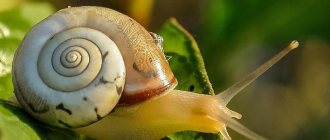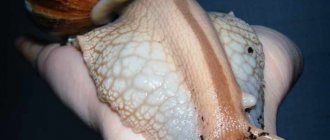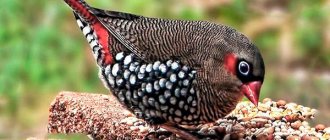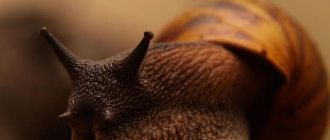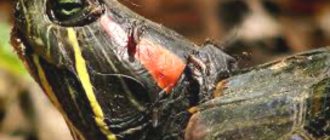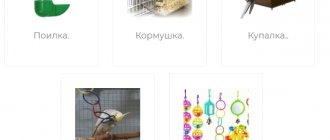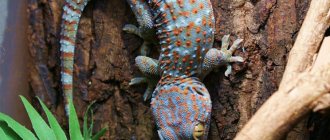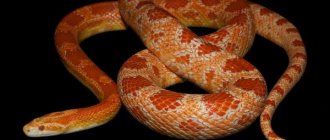Photo from the site otvet.mail.ru
Pet lovers can be divided into two camps. The first ones will not live a day without chasing their pet around the park, without having fun playing with it in the morning, lunch and evening. Such owners prefer active animals, splashing out their energy with them. Representatives of the second camp, people who prefer a calmer lifestyle, silence and regularity. And if earlier such lovers most often became owners of fish or turtles, now snails have also been added to this list. How to care for Achatina at home, what these snails eat and what are the features of their maintenance, you will learn from our article.
The giant snail Achatina - who is it?
Photo from the site www.otvetprost.ru
Many people watched snails as children. While playing near a river or lake, one could meet many of these tiny animals carrying their home. But hardly anyone was able to meet individuals larger than a walnut.
Achatina lives in tropical countries and is the largest of all snail species. During their life cycle, they grow to a size of about 10 cm, although in nature there are some representatives that reach a length of 20 or even 30 cm.
They live in many African countries, but are not found in Russia due to the climate. But, considering that these are one of the participants in the top 100 agricultural pests, this is rather a reason for joy. If in the wild Achatina are more likely to cause harm, then as a pet they are very unpretentious, interesting and therefore in demand among exotic lovers.
This mollusk smells with the tips of its tentacles, feels the shape of objects with its soles, breathes through its skin and hears nothing at all.
The color of the shell directly depends on what was eaten. Color may vary. The monochromatic color is replaced by a multi-colored pattern and vice versa.
There are about 100 species: common, lemon, brown Achatina, fulica and reticulata snails. Since all of them are unpretentious, the choice of a pet is based more on aesthetic criteria, such as the color of the shell and its shape.
Use in cosmetology: benefit or harm?
Today, mollusks are actively used in cosmetology. Scientists have discovered that Achatina mucus contains a lot of allantoin, elastin, collagen, peptides, glycolic acid and arathan sulfate.
Table: benefits
| Slime Component | Properties |
| Allantoin | Regenerates the skin, fights free radicals |
| Peptides | Destroy pathogenic organisms |
| Vitamins A, C and E | Relieve inflammation on the skin, moisturize it |
| Collagen | Promotes the synthesis of natural collagen |
| Glycolic acid | Cleanses the skin |
Snail mucus is usually not harmful. It is not recommended to use them in cosmetology for people with hypersensitivity or allergic tendencies.
Massage procedures are very popular in cosmetology. The snail is washed and placed on the person’s face for a certain time.
Massage helps:
- Narrow pores.
- Get rid of expression wrinkles.
- Get rid of bags under the eyes.
- Prevent skin peeling.
- Increase the elasticity of facial skin.
Benefits of Achatina snails
Photo from the site www.arsvest.ru
Many owners call these unpretentious creatures ideal pets. Beautiful, but slow and “not talkative” animals are pleasing to the eye and do not hurt the ears.
These mollusks are capable of hibernating for almost two months. So with them, you won't have to worry about asking your neighbors or relatives to look after your pets while you're on vacation. You can safely go to the seaside or visit your grandmother in the village or on a trip across the country. The animal hibernates in the absence of food and the presence of very dry soil in the terrarium, so it is better to start preparing for sleep in advance. When you return from a trip, hold your pet under warm water for about 10 minutes and then feed it immediately.
It is believed that Achatina is able to remember their owners. They love touch and bathing in warm water. Over time, they may develop reflexes to certain actions of the owner. Considering that their long memory is only about one hour, this achievement cannot but rejoice.
Pets will not cause any damage to your furniture or clothing.
They do not cause allergies and therefore can easily become friends with an allergic owner.
Interesting Facts
- The movement speed of grape snails is on average 3-4 mm per second. The maximum fixed speed is 7 mm.
- Mollusks can move freely not only on horizontal planes, but also on vertical ones.
- A video of snails mating gets about a million views on the Internet.
- Snail meat contains a balanced amount of BJU, as well as vitamins and microelements.
- The grape snail was the symbol of one of the communes in Switzerland. She is depicted on the coat of arms of this institution.
- From the body you can prepare helicidin, a medicinal extract with bronchodilator properties.
- The average lifespan of these creatures is 7-9 years. However, there are cases where a grape snail at home lived to be 17, 19 and 21 years old.
- 95% of grape snails die before reaching sexual maturity.
- The blood of mollusks is completely colorless.
- Grape snails began to be bred for food in the first century AD.
Disadvantages of Achatina snails
Photo from the site moy-pitomec.ru
They are unpretentious in food, which is a plus, but they eat a lot and often, which affects the regularity of their toilet. And that means the frequency of cleaning the terrarium. If you do not maintain hygiene in the snails' home, midges and microbes will appear there, which will greatly complicate your life.
If you are a sensitive sleeper, then you should not have more than one pet of this type. Since these animals are usually active at night, the unpleasant sound of several shells rubbing together will disturb your sleep.
Reproduction in Achatina
Photo from the site shkola-v.blogspot.ru
One of the main disadvantages is reproduction. It is not for nothing that Achatina is included in the list of the main pests of agricultural crops. In just one clutch they produce up to three hundred eggs, which you will have to remove regularly. Unless you decide to start breeding these slow-moving house-bearers. The number of clutches reaches 4-6 per year.
It is quite interesting to know how Achatina reproduces. During the first year of an animal's life, it reaches full sexual maturity. And what’s interesting is that for procreation, a second partner is not always required. Giant snails are hermaphrodites, that is, they carry both feminine and masculine principles. And in a critical state for the population (solitary life in an aquarium is also suitable here), individuals are capable of self-fertilization. So even if you purchase just one pet, you run the risk of discovering a clutch of eggs. We remind you that even at one time there can be several hundred such eggs.
To minimize the process of egg laying, you need to make the thickness of the coating in the home less than 3 cm. This will complicate the process and most likely prevent it.
If you nevertheless notice eggs in the terrarium and do not want to frantically distribute the offspring to relatives, friends and neighbors in a couple of weeks (this is the period needed for the babies to hatch), then you will need the following. It will be necessary to collect all the eggs (they are similar in shape to chicken eggs, but the size of one does not exceed 5 mm). The next steps are quite brutal. Eggs need to be either boiled or frozen. Unfortunately, there is no other way to get rid of the pet's possible offspring. It is not recommended to simply throw away eggs. After all, a hundred hatched ones can harm the environment, and if each of them produces the same offspring, then a snail apocalypse on your street is inevitable.
In England, there is a special law prohibiting the release of Ahahatina into the wild due to their destructive love of agricultural crops.
Breeding
The molluscarium can be arranged in a terrarium similar to its maintenance. In winter it should stand in a warm corner, and in summer even outside. Only they need to be protected from attacks by dogs, cats, birds, hedgehogs, shrews, and snakes.
For successful reproduction, the temperature is slightly increased to +20…+23 °C, and at night it is reduced by a couple of degrees. The soil substrate in the tank is moistened twice a day.
Grape snails are hermaphrodites. In nature, individuals mate in the spring. Instances seeking to copulate persistently crawl, looking for each other. During fertilization, the mollusks press against each other with all surfaces of their legs.
At the same time, elastic white processes extend below the mouth on the right side of the body, which quickly change shape, then hiding, then appearing again. When they touch, they increase in size. The process lasts about 2 hours. During this entire time, individuals prick each other with special calcareous plates (“love arrows”). Apparently their purpose is to stimulate fertilization.
One adult can lay up to 60 eggs; clutches are usually made at a depth of 5-10 cm. Therefore, such a substrate thickness should be provided for in molluscaria. The masonry is surrounded by a special mucous substance, so in appearance it often resembles a bunch or a cocoon.
Snails hatch up to 2.5 mm in diameter, their shells are completely transparent and have one or two turns. The hatchlings eat the remains of the egg and begin to slowly crawl upward, reaching the surface in about a week, sometimes 10 days. At the same time, they feed on useful substances from the soil substrate.
How quickly do Achatina snails grow and how long do they live?
Photo from the site justsovet.ru
The most active level of growth occurs in the first 2 years of a mollusk’s life. The growth process continues throughout life, but slows down significantly over time.
Under living conditions in a terrarium, they can live for about 5-10 years. The better you take care of your pet, the longer it stays with you.
Achatina snail: maintenance and care at home
In order for your pet to feel as comfortable as possible in your house or apartment, take care of the ideal home for it.
Choosing a house
Use a container, aquarium or terrarium.
One medium-sized snail feels comfortable in a 10-liter container. The larger the pet becomes, the larger the house will have to be purchased for it.
The closer the conditions inside the home resemble those that exist in the wild, the more comfortable the snail will feel.
The top of the container must be protected with a lid. To allow fresh air to enter the house, move the lid a little or arrange small openings. You can place moss, fragments of clay pots, and poorly rotting wood at the bottom. It wouldn't hurt to plant ferns or ivy. This will make your home more comfortable and beautiful. And live plants will purify the air in the aquarium.
It is not recommended to use sand or peat as a substrate (filler). The walls will be constantly dirty, and sand also encourages individuals to lay eggs, the disadvantages of which we have already written about.
In any case, it is necessary to clean the room as it gets dirty. Typically this will be required once a month or every few months. We are talking about cleaning glass and changing the substrate. It is advisable to remove your pet’s waste products daily. This will not take much time, but will ensure the cleanliness of the snail’s home, and therefore yours.
Photo from the site polzavred.ru
Many owners begin to worry about the lighting of the house and even purchase special lamps. In fact, the intensity of the rays has no effect on the snails. On the contrary, they lead an active lifestyle in a darkened environment, but when sunlight appears, they hide in the substrate.
However, Achatina, natives of the African continent, will need heating lamps. Especially during the harsh Russian winters. You should not install the lamp directly in the terrarium; snails may start crawling on it and get burned. Let it be located in close proximity to the home, but not inside it. For the same reason, you should not install the terrarium near the battery.
Humidity is another criterion when arranging a home. If your pet is hanging on the walls, then this is a sure sign that the humidity is high. To do this, you need to dry the surface by directing the sun's rays inside. If there is a lack of moisture, the mollusk will hide inside the shell. In this case, use a spray bottle to spray the filler and everything will fall into place.
Photo from national-travel.ru
One of my favorite activities is swimming. Be sure to do this under warm water, but under a tap or shower: it doesn’t matter. If the pet is uncomfortable, it will hide under the sink. This means you can change the water pressure or make it a little warmer/colder.
Large and beautiful mollusk shell
A healthy and beautiful snail shell is its pride.
It is created by special glands at the edge of the shell. Often the health of a mollusk is judged by its growth on the shell. If Achatina does not receive enough calcium, the growth is very fragile and easily breaks when touched. The condition of the shellfish is influenced by many factors, for example, dry and dirty substrate, rotting food debris, direct sunlight, contact with salt, chemicals and detergents. The snail's growth can stop its pregnancy, so keep the snail away from others. The sexual maturity of the mollusk is signaled by a white bulge on the neck.
What to feed Achatina snails at home
Photo from the site polzavred.ru
With these pets you don't have to choose between dry food and table food. Giant snails are voracious creatures and will eat anything you offer them. Of course, they will give preference to food of plant origin. Moreover, young animals prefer fresher plants, and the older the individual, the older, even rotten, food it prefers. The number of feedings also depends on age. Owners feed young animals every day, and adult pets once every few days.
The standard diet includes carrots, cabbage, and cucumber. But you shouldn’t limit yourself to this set. Include in the menu:
- greens (clover, dandelion, plantain, nettle, other meadow and field herbs);
- fruits (literally everything that is enough for your imagination and wallet, from apples to figs);
- berries;
- vegetables (champignons, broccoli, zucchini, spinach, etc.);
- legumes and peas.
In nature, snails do not disdain heavier food. Therefore, from time to time you can treat your pet with pieces of boiled meat, eggs or mushrooms.
Like any animal, over time yours will begin to show a gastronomic interest in certain types of vegetables or fruits. Pamper your pet with them from time to time.
Photo from masterok.livejournal.com
In addition to plants, Achatina’s diet must include calcium. This element is a prerequisite for the construction of a sink. This could be crushed eggshells, feed chalk, sepia. If there is not enough calcium in the animal’s body, the shell will be soft and easily deformed. Which can lead to its loss over time. And instead of a snail with a beautiful shell, you will have a slug living with you.
Calcium can also be obtained from ready-made mixtures that are sold in pet stores.
Do not forget that along with food, there should always be drinking water in the aquarium. Make sure that the bowl is heavy enough in weight, because if the snail constantly turns it over, then the humidity in the home will be constantly increased.
What to avoid on the menu: fried, smoked, flour, sweet, sour, salty. Saying “No” to such products will be beneficial for both the pet and the owner.
We draw conclusions: why do we need snails at home?
These animals embody slowness and passivity in its purest form. From them you can learn to avoid fuss and be a little slower, calmer, and more detached in the cycle of daily affairs.
This “beast” will be an excellent companion for not the most responsible owners. He will eat almost everything you cook, will fall asleep during your vacation, will not demand to play in the middle of the night and ask to go to the toilet early in the morning. It will brighten up your life without requiring constant attention and care.
Once you meet the Achatina, you will become friends for many years.
